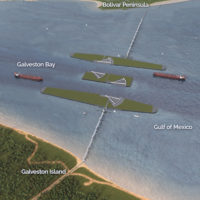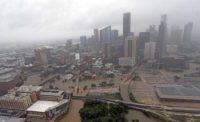Hurricane Ivan made landfall near Gulf Shores, Ala. early Thursday morning, flinging hard punches at nearby Florida Panhandle cities and beaches, cutting a segment of one Interstate bridge, wrecking power lines and damaging critical facilities.
Ivan stuck as a Category 3 storm with sustained winds exceeding 125 miles per hour, and a storm surge estimated at 16 ft. It weakened after coming ashore to a Category 1 status and 80-mph winds, but its path of destruction is broad. It is spawning tornadoes and heavy rains as it careens through Alabama bound for Tennessee. In Greensboro, Ala., about 160 miles north of the coast, the storm peeled the metal roof off of a National Guard Armory with about 100 people inside shortly after 9 a.m. No injuries were reported.
Power outages are extremely widespread with Alabama Power Co. officials predicting that about a million of the system's 1.5 million customers could be in the dark before Ivan finishes with the state. Mobile, a city of 200,000, reported the power was out for 170,000 of its citizens. New Orleans, about 150 miles west of where the eye came ashore, was largely spared.
Pensacola, about 35 miles east of the storm center at landfall and therefore in its most potent quadrant, was hit hard. Early reports indicate the storm knocked out a quarter-mile section of the eastbound side of the dual bridge, Interstate 10 crossing over Escambia Bay on the northeast side of the city. The westbound side was also damaged but is still standing. All four of Escambia County's hospitals also report major damage and several storm shelters were reported to have had serious roof damage.
Two main pumps feeding the Pensacola's Main Street Sewage Treatment Plant failed, resulting in spillage into Pensacola Bay, and heavy erosion was reported at Pensacola Civic Center Beach, renourished two years ago at a cost of $20 million.
The damage to the bridge at Pensacola severed the main routes between Pensacola and the rest of the Florida to the eastU.S. Route 90 and I-10, delaying about 1,000 National Guard troops who are en route to the area.
|
As Hurricane Ivan began moving inland, President Bush on Sept. 16 added Alabama, Mississippi and Louisiana to the list of states declared to have suffered major disasters. Michael Brown, the Dept. of Homeland Security's under secretary for emergency preparedness and response, says that DHS and its Federal Emergency Management Agency unit "have the resources in hand to meet critical emergency needs and are prepared to deliver them as fast as humanely possible."
FEMA says the disaster declaration clears the way for release of federal emergency aid and long-range recovery assistance in the states' affected counties. It also permits local jurisdictions to apply for federal money to cover 100% of approved costs for emergency services and removing debris for up to 72 hours and 75% of the costs after that.
Elements of the U.S. Army Corps of Engineers are moving to respond even as Ivan continues to pound the Southeast. Corps Districts including Jacksonville, Wilmington, Vicksburg, and Mobile have teams on the ground or moving toward the area. Emergency supplies of ice and water, and emergency power generators are identified and some are already moving today.
Full emergency response operations will get underway over the weekend, as the storm leaves the initial impact area and moves north. Because the storm is expected to stall and drop major rainfall in areas already waterlogged from previous storms, the U.S. Army Corps of Engineers is planning for potential flood fights along the storm track in Alabama, Georgia, Tennessee, Kentucky, and the Carolinas.



Post a comment to this article
Report Abusive Comment